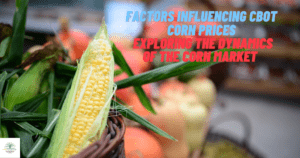 |
| “Exploring the intricacies of CBOT Corn Prices, from weather to demand, in the ever-changing landscape of the Corn Market.” |
The corn market is a significant component of the global agricultural commodities
industry, with CBOT corn prices serving as a crucial benchmark for market participants. Factors Influencing CBOT Corn Prices is important part of corn market.
In this article, we will explore the various factors that influence CBOT corn
prices, including supply and demand dynamics, weather conditions, government
policies, and global economic factors. By understanding these factors, farmers,
grain traders, and speculators can make informed decisions and navigate the
ever-changing corn market landscape.
Supply and Demand: The Fundamental Balance
One of the primary factors influencing CBOT corn prices is the fundamental relationship
between supply and demand. The balance between these two forces determines the
price levels and can lead to significant fluctuations.
Factors Affecting Supply:
- Crop Yields: Corn production is subject to variations in crop yields due to factors such as weather
conditions, disease outbreaks, and technological advancements. Higher crop
yields result in increased supply, leading to potential downward pressure
on prices.
- Stock Levels: The levels of corn stocks, both domestically and globally, influence market dynamics. High
stock levels tend to suppress prices, as they indicate ample supply.
Conversely, low stock levels can lead to price increases, signaling
potential scarcity.
- Consumption Patterns: The demand for corn in various sectors, such as animal feed, food production, and biofuels,
impacts supply. Changes in consumption patterns or shifts in demand from
one sector to another can affect corn prices.
Factors Affecting Demand:
- Animal Feed Industry: Corn is a vital ingredient in animal feed formulations, making it highly dependent
on livestock production. The growth or decline of the animal feed industry
directly affects corn demand and subsequently influences prices.
- Food Production: Corn is used in various food products, including cereals, snacks, and sweeteners. Changes
in consumer preferences, population growth, and dietary patterns can
impact corn demand in the food production sector.
- Biofuels: The development of biofuels, particularly ethanol produced from corn, has created a
significant additional demand source. Government policies promoting
renewable energy and carbon reduction can further amplify the influence of
biofuel demand on corn prices.
Weather Conditions: Nature’s Impact
Weather conditions play a crucial role in shaping CBOT corn prices, as corn production
is highly susceptible to climatic factors during planting, growth, and harvest
periods. Unfavorable weather events can disrupt crop production and impact
prices.
 |
| Weather significantly impacts corn crops. Droughts harm yields, while ideal conditions with warmth and rain boost growth and productivity. |
Adverse
Weather Events:
- Droughts: Extended periods of
low precipitation can lead to drought conditions, adversely affecting corn
crops. Insufficient water availability reduces crop yields, leading to
supply shortages and price increases.
- Floods: Excessive rainfall or
flooding can saturate the soil, preventing proper root development and
causing waterlogging. Floods can damage corn plants, reduce yields, and
disrupt transportation, impacting prices.
- Extreme Temperatures: Extreme
heat or cold can stress corn plants, affecting their growth and
development. Heatwaves or frost events during critical growth stages can
lead to yield losses, ultimately influencing prices.
Farmers,
grain traders, and speculators closely monitor weather forecasts and historical
data to assess the potential impact of weather conditions on corn production
and anticipate price movements.
Government Policies: Shaping the Market Landscape
Government policies play a significant role in shaping CBOT corn prices through
regulations, subsidies, and mandates that influence supply, demand, and market
dynamics.
Key Government Interventions:
- Subsidies: Governments may provide financial incentives to farmers, such as subsidies for crop inputs
or direct payments, to support corn production. These subsidies can impact
production costs, supply levels, and ultimately, corn prices.
- Tariffs and Trade Regulations: Governments can impose tariffs on imported corn to protect domestic
producers, potentially reducing competition and increasing prices.
Similarly, trade regulations, such as import quotas, can influence market
access and price dynamics.
- Biofuel Mandates: Government mandates requiring a certain percentage of biofuels in transportation
fuels can significantly impact corn prices. These mandates create
additional demand for corn, increasing prices and affecting corn market
dynamics.
Farmers and market participants closely monitor government policies and their potential
impact on corn prices to make informed decisions and adapt to changing market
conditions.
Global Economic Factors: The Big Picture
Trends in the global economy and geopolitical events can influence CBOT corn prices
through various channels, including trade relationships, exchange rates, and
overall economic growth.
Global Economic Indicators:
- Economic Growth: The overall health of the global economy, including GDP growth rates, income levels,
and consumer spending patterns, impacts corn demand. Strong economic
growth can increase demand for corn-based products, leading to higher
prices.
- Exchange Rates: Changes in exchange rates between currencies can affect corn prices for countries involved
in international corn trade. A weaker domestic currency can make corn
exports more competitive, potentially increasing demand and prices.
- Geopolitical Events: Political instability, trade disputes, and changes in trade agreements can disrupt
global corn markets. Import/export restrictions, market access
limitations, or shifts in trade relationships can influence corn prices.
Market participants must stay informed about global economic trends and geopolitical
developments to anticipate potential impacts on corn prices.
Trends in CBOT Corn Prices
CBOT corn prices have exhibited various trends over the years, influenced by a
combination of factors and market dynamics. Understanding these trends can help
market participants make informed decisions and manage their risk exposure.
Q: How can farmers gain from monitoring CBOT corn prices?
A: Farmers can use CBOT corn fees as a reference point to make informed decisions
regarding planting, promoting their crop, and managing charge risks. Through
tracking the marketplace, farmers can optimize their sales and mitigate
capacity losses.
Q: What effect do global weather conditions have on CBOT corn costs?
A: worldwide weather conditions, particularly in main corn-producing regions like the USA,
Brazil, and Argentina, can notably impact corn charges. Unfavorable climate
situations, including droughts or floods, can lessen crop yields, leading to
decrease deliver and better fees.
Volatility and Price Swings:
- Corn prices are known for their volatility, reflecting the dynamic nature of the corn market. Changing
market dynamics, weather-related uncertainties, and unforeseen events can
result in large price swings, creating both opportunities and risks.
- Price Seasonality: Corn prices often exhibit seasonal patterns due to planting and harvest seasons and
weather outlooks. Supply expectations during these periods can lead to
seasonal price movements, which market participants can capitalize on.
- Biofuel Demand Impact: The increased demand for biofuels, particularly ethanol produced from corn,
has had a significant influence on corn prices. Government policies
promoting renewable energy sources can amplify this effect, driving up
corn prices.
- Trade and Export Dynamics: Corn is a globally traded commodity, and international trade dynamics play a
crucial role in price trends. Changes in trade policies, market access,
and export demand can impact CBOT corn prices.
Market participants should monitor historical price data, analyze market trends, and
stay informed about the latest developments in the corn market to make informed
decisions.
Conclusion
CBOT corn costs function a critical reference for the corn market, reflecting the interplay of
supply and call for dynamics, climate conditions, authorities rules, and
international economic elements.
By way of understanding those factors and monitoring tendencies in CBOT corn fees, farmers, grain traders, and
speculators could make properly-informed choices and navigate the complexities
of the corn marketplace.
Live up to date on marketplace developments, leverage
ancient information, and use to be had resources to optimize your techniques
and stay in advance within the dynamic international of CBOT corn trading

